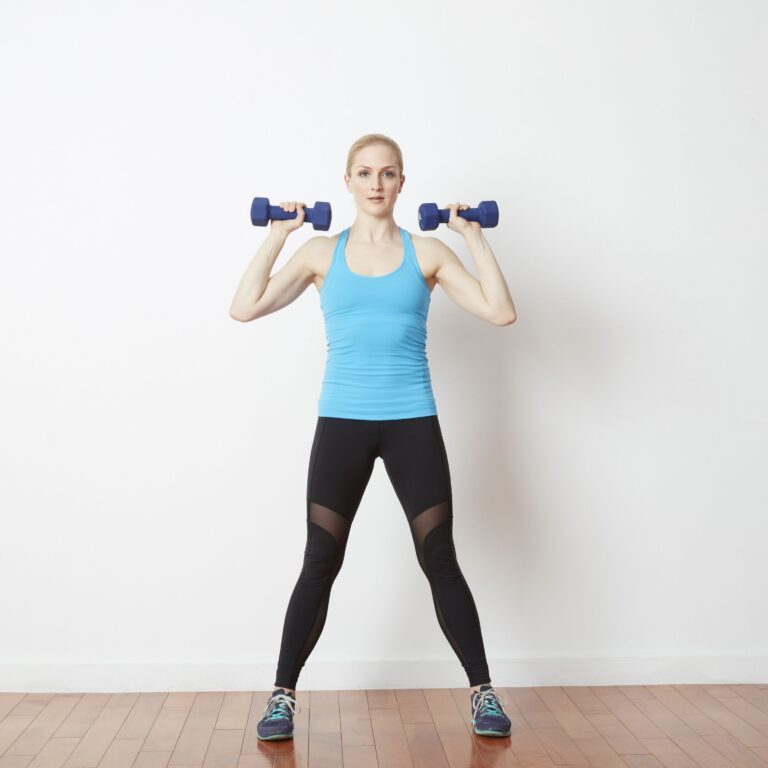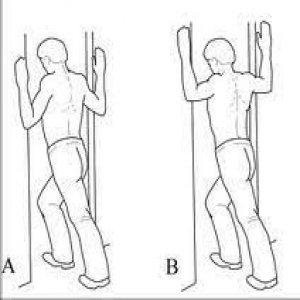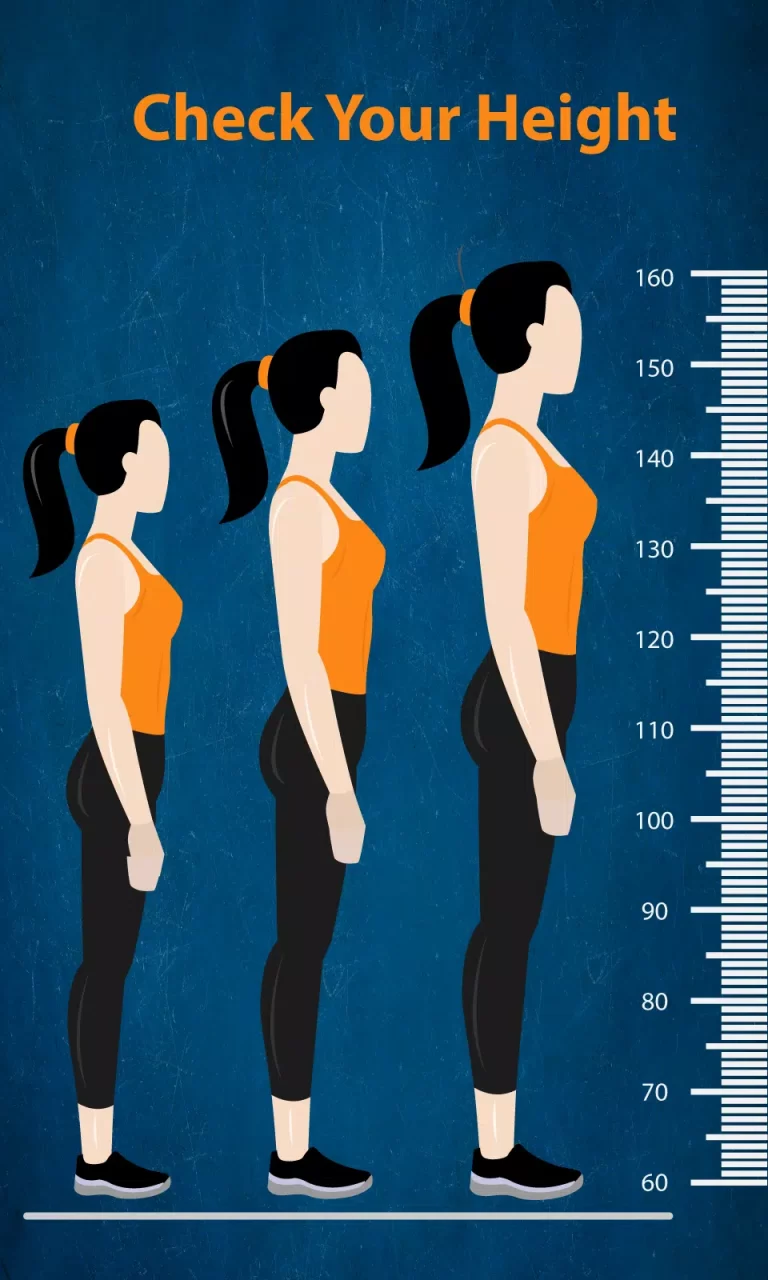11 Best Exercise for tennis elbow with Physical Therapy and Preventive Tips
Exercise is an important part of the overall treatment Program for the Tennis Elbow, along with Pain medication, an Elbow brace, and the use of Ice packs or Hot packs.
Exercise for Tennis Elbow helps to recover permanently and also makes your Elbow muscles fully functional. It is the most natural way to recover and also helps to start all the day-to-day activity that was earlier painful and you can also play sports again.
Introduction
The tennis elbow is also known as lateral epicondylitis. It occurs when a person sprains the tendons in their forearm. People can usually treat tennis elbow at home with rest & over-the-counter medication. Doing specific exercises can also help ease the pain & inhibit reoccurrence.
Some various treatment methods can be used at home or after consulting a physician.
Rest: Resting the arm is most important. A break in activity allows the torn tendon attachment to recover. Tennis players treat more serious major cases with ice, anti-inflammatory drugs, soft tissue massages, stretching exercises, & ultrasound therapy.
Physical therapy: Physiotherapists commonly advise that racquet sports players strengthen their shoulder, upper arm, & abdominal muscles. This can help to decrease the wrist extensors during shoulder & arm motions.
Ice massages & muscle stimulating techniques: These can also help the muscles to recover.
Strapping or taping the forearm: Supporting the area can help realign the muscle fibers & relieve pressure on the area. A physician may recommend using a splint for two to three weeks to take the elbow joint out of action.
Tape, straps, or braces for support: Bracing or splinting the wrist joint is another way to manage tennis elbow A brace for tennis elbow typically involves the wrist joint. Bracing the wrist joint can limit uncontrolled stress on the tendons which connect to the outside of the elbow joint.
What to do after an injury?
Home treatment
People with tennis elbow don’t typically need to see a doctor. By stopping the repetitive activity & resting the arm, & the pain usually eases within two weeks.
A person can manage tennis elbow at home by:
- Taking over-the-counter painkillers, & such as ibuprofen or another non-steroidal anti-inflammatory drug
- using an ice pack, heat pack, or hot water bottle on the injured area to settle the pain
- learning how to protect the joints to avoid recurrently
If exercising the forearms seems to increase symptoms of tennis elbow, a person can try:
- resting the arm for longer
- using an ice pack on the arm to help decrease inflammation
- taking pain relieving medication, such as ibuprofen, for the relief of pain & inflammation
- speaking to a doctor or physiotherapist to make sure they are doing the exercises properly and safe
Why Physical Therapy?
- The goal is to improve the strength & flexibility of your forearm muscles so you would not be bothered with tennis elbow again. Your physiotherapist may also teach you ways to change your tennis stroke or other activity that is causing your elbow troubles.
- Physical therapy can also help increases blood flow to the tendons, which do not get the same level of blood & oxygen supply as muscles normally receive.
- Exercises that increase blood flow will improve recovery, too.
Initial treatment for Pain Relief
- Your physical therapist will start with pain relief, & then show you exercises that stretch & strengthen your muscles.
- They will try to ease the pain & help your body recover with things such as:
Ice massage
Massage the lateral side elbow joint with ice for 5-10 minutes until the skin is cool to the touch. You can use a Dixie cup filled with water & frozen, or an ice cube held with a towel. If ice is too cold directly on the skin, you can place a damp washcloth over the area & by a direct route ice on top of that.
Muscle stimulation
TENS Therapy for tennis elbow can help you recover from the pain. The skin electrodes transfer the stimulation current pulses to the nerves. This prevents the nerves from transferring the pain stimulus to the brain. In addition, blood circulation can be increased.
Ultrasound Therapy
Patients aching from chronic tendon pain now have a minimally invasive treatment option that uses high-frequency sound waves or ultrasounds to remove injured and scarred tissue that reason the tendon pain.
You will also learn tips on how to rest your elbow joint & take the strain out of everyday living activities.
Exercises for tennis elbow
The following exercises can help rehabilitate treatment for tennis elbow:
Wrist turn

To perform a wrist turn:
- bend the elbow at a right angle
- extend the hand outwards, palm facing up
- rotate the wrist around gradually, until the palm, is facing down
- hold the position for 5 seconds
- repeat nine more times
- do two more sets of 10 repetitions
Wrist turn with weight
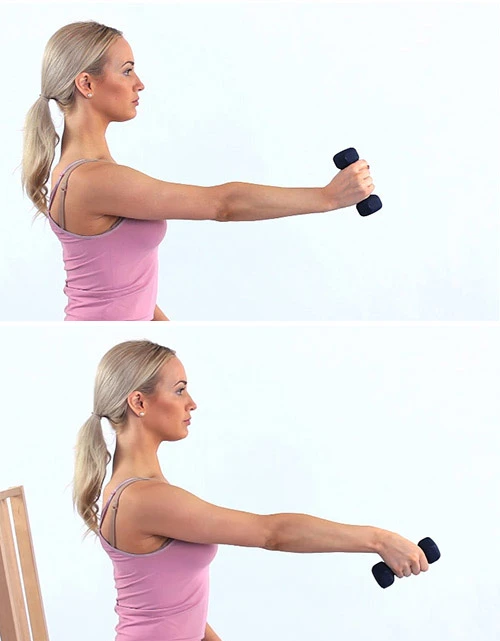
The wrist rotates with weight the same as the wrist joint rotates above. But, in this version, the person also grips a lightweight, such as a small dumbbell or a tin of food.
Wrist lift, palm up
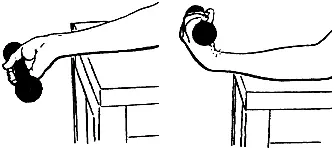
To perform a wrist lift, palm up:
- grip a lightweight, such as a small dumbbell(500 gms) or a tin of food
- bend the elbow at a right angle
- extend the hand outwards, palm facing up
- bend the wrist up toward the body
- hold this position for five seconds, & then release slowly
- repeat nine more times
- do two more sets of 10 repetitions
Elbow bend
To perform the elbow bend:

- stand straight
- lower the arm to one side
- slowly bend the arm upwards until the hand touches the shoulder joint
- hold this position for 15 to 30 seconds & then relax the position
- repeat nine more times
Wrist extensor
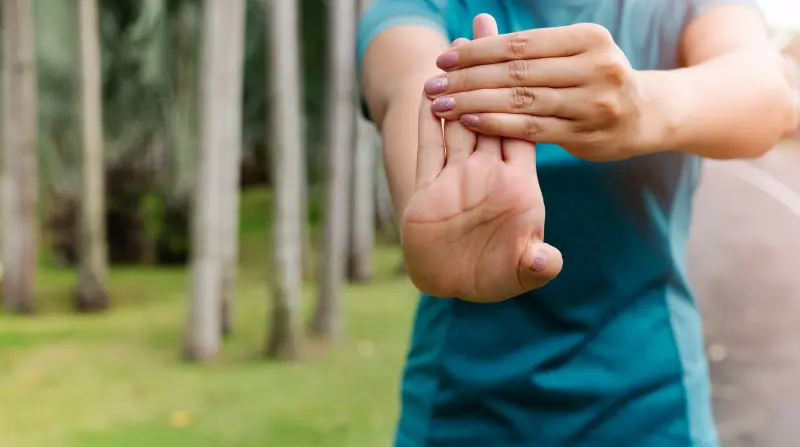
To perform the wrist extensor:
- elevate the arm straight out in front of the body
- with the palm facing down, & slowly bend the wrist joint downwards
- using the other hand, gently pull the stretching hand back toward the body
- hold on to this position for 15 to 30 seconds and then relax
- straighten the wrist again
- repeat twice
- do two more sets of 3 repetitions
Wrist extensor flex
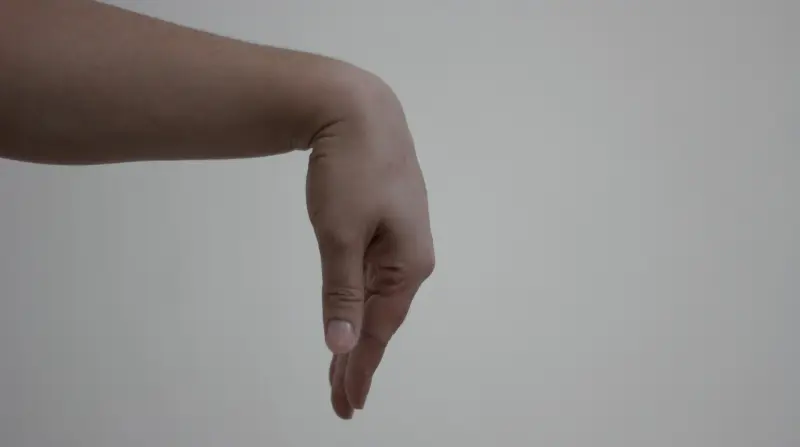
To perform the wrist extensor flex:
- elevate the arm straight out in front of the body
- with the palm facing down, & slowly bend the wrist joint upwards
- using the other hand, gently pull the fingers back toward the body
- hold on to this position for 15 to 30 seconds and then relax
- straighten the wrist again
- repeat twice
- do two more sets of 3 repetitions
Fist squeeze
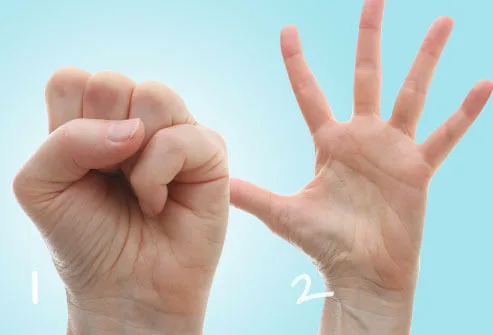
To perform the fist squeeze:
- used a rolled-up towel, sock, or tennis ball & place it in the palm
- pinch the towel or ball with the fingers to form a fist & squeeze
- squeeze tightly for 10 seconds
- repeat nine more times
Towel Twist

To perform the towel twist:
- hold a loosely or roughly rolled-up towel lengthways, & with one hand at each end
- keep the shoulders relaxed
- twist or rotate the towel by turning or moving the hands in opposite directions, as if wringing out water
- repeat nine more times
- then repeat 10 more times twisting or rotating the towel in the reverse direction
Fist clench
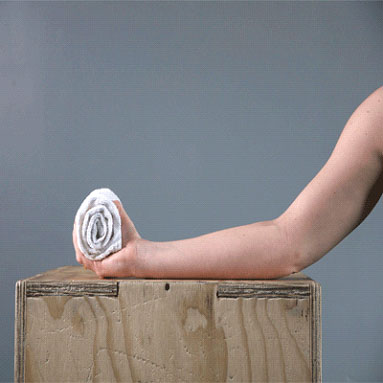
Poor or weak grip hand strength is a common symptom of tennis elbow. Increasing grip strength by raising your forearm muscles can help increase your ability to perform daily living activities.
Equipment needed: table & towel
Muscles performed: long flexor tendons of the thumb & fingers
- Sit at a table with your forearm relaxing on the table.
- Hold a rolled-up towel or small ball in your hand.
- Pinch the towel in your hand & hold it for ten seconds.
- Release and repeat 10 times. Repeat with the other arm.
Supination with dumbbell
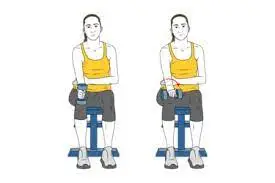
The supinator muscle is a large muscle of your forearm that connects to your elbow. It is responsible for rotating your palm up & is often involved in motions that can reason tennis elbow.
For all the supination exercises listed below, it is recommended that you first practice isometric supination without weights: With your elbow fixed, & turn your palm up & hold for about 30 seconds.
Equipment needed: table and 1-pound dumbbell
Muscles worked: supinator muscle
- Sit in a chair, & holding a two-pound dumbbell vertically in your hand, & with your elbow joint resting on your knee.
- Let the small weight of the dumbbell help rotate your arm outward, & turning your palm up.
- Turn your hand back in the other direction until your palm is facing down.
- Repeat 20 times on each side.
- Try to isolate the motion to your lower arm, & keeping your upper arm & elbow joints still.
General stretch exercise for tennis elbow
Once the pain eases, you’ll move on to exercises. How long it takes to get better is dependent on the severity of your symptoms. It could take up to eight weeks or even longer to see results.
This is a no pain, no gain exercise situation. If you are hurting, stop. Pushing through it only makes it dangerous.
With the exercises below, the number of repetitions & how often to do them is just a guideline. Follow your physiotherapist’s advice & program. And listen to your body. If ten reps hurt, so start with five. If doing them every day feels like a strain, try every other day or alternate day to work your way up.
To give you an idea of what physiotherapy might involve, here are some of the general exercises:
Finger stretch:

- Touch your fingers to your thumb & put a rubber band around them, & including your thumb.
- Slowly open your thumb & fingers all the way, & then close them.
- Repeat up to 25 times.
- Do this stretch up to 3 times a day. If it gets too easy, & try 2 rubber bands.
Wrist flexor stretch:
- Hold your arm straight out so your elbow is not bent or flexed & your palm faces up.
- Use your other hand to hold the fingers of your outstretched hand & bend or flex it. back toward your body until you can experience it in your inner forearm.
- Hold for 15 seconds.
- Repeat three to five times.
- Do this two or three times a day. You can hold it for up to 30 seconds & work your way up to repeat 5 to 10 times instead of 3 to 5.
Wrist extensor stretch:
This is just like the last stretch of the affected forearm, but your palm faces down instead of up:
- Hold your arm straight out so your elbow is not bent or flexed & your palm faces down.
- Use your other hand to hold the fingers of your outstretched hand & bend it back toward your body until you can feel it in your outer forearm.
- Hold for 15 seconds.
- Repeat three to five times.
- Do this two or three times a day. You can hold it for up to 30 seconds & work your way up to repeat 5 to 10 times instead of 3 to 5.
other exercises involve tennis elbow
Stretches & gradual strengthening exercises requiring the use of little weights or elastic bands can be helpful. They can improve pain-free grip strength & forearm strength.
Exercising during a case of tennis elbow is vital for recovering muscle strength & decreasing pain.
Despite painful sensations, & it is achievable to ease into an exercise routine program through first stretching. The most common important difficulty of the movement until it is only possible to complete 10 lifts. Start with lower weights & increase the difficulty of the movements until it is only possible to complete 10 elevates.
Here is an example of a simple exercise to recover or heal tennis elbow symptomsTrusted Source.
The Tyler Twist
- Find a long, & thin object you can grip easily with both hands. It is preferable to apply an easily flexible item that still produced resistance while being twisted. A rolled-up towel or small pillow can work. People practicing the Tyler Twist often an apply exercise tool called a FlexBar.
- Hold the piece vertically in the front line of your chest & relax.
- Grip the object with both hands, & with your hands facing the same way. Both wrists should be fully extended or bent(flexed) back.
- Move the wrist affected with the tennis elbow into flexion, or a bent-forward position, around the object.
- Keeping the wrist in flexion, turn the object into a horizontal position as if you were griping the handlebars of a bicycle. Hold your arms straight out in the front line of your body.
- Move the normal wrist into flexion, joining the affected wrist.
- Perform 3 sets of 15 repetitions a day until symptoms improve
Conditioning program for tennis elbow
Forearm strengthening:
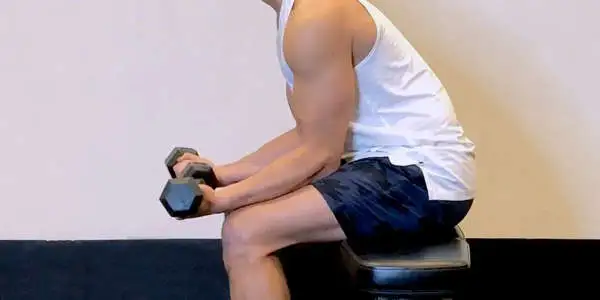
- Grab a 1-pound dumbbell or a tool like a hammer or a wrench & take a seat.
- Support your forearm on your thigh or the edge of a table so that your wrist joint hangs over the edge.
- Grip the bottom of the dumbbell, not the middle, as usual.
- Slowly rotate your hand so your palm faces up. Make sure to only move your forearm, not your elbow joint.
- Slowly turn your palm to the ground.
- Repeat 10 times.
- Do this 1 or 2 times a day, more if you are up to it. You can also work your way up to repeat 20 times instead of ten.
Eccentric and concentric exercises:

- Start with a 1one or two-lb dumbbell & sit on a chair at a table that has an edge.
- Bend or flex the elbow to 90º; & the palm should be facing the floor. & Slowly down the weight, then slowly elevate. This may be painful but elevate & down the weight 10 times or until you can not anymore.
- Rest a few minutes.
- Fully straighten the elbow joint flat across the table, & with your palm facing the floor. Slowly down & elevate the weight 10 times.
- When the 10 repetitions have become easy to do, & accelerate the weight by 1 or 2 pounds. Continue regular exercises once a day for about 3 months. The pain should begin to relent in a month to six weeks.
- After Your Program Is Over
- Once your elbow joint is pain-free & your backhand is better than ever, you should continue to keep your muscles strong & flexible.
- That is because everyday activities do not keep your muscles as strong & flexible as they should be to keep away from sports injuries.
- Talk to your physiotherapist or doctor about the best ways to continue keeping your elbow joint working at its best.
Elbow Curls
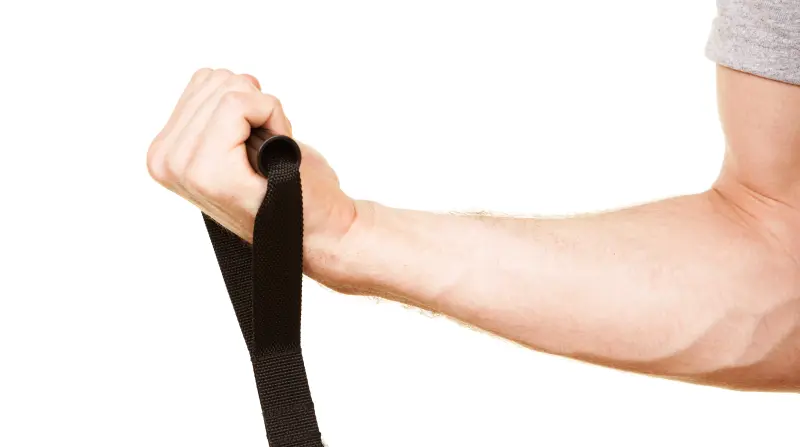
- Though curls can sometimes worsen tennis elbow pain, it is very important to strengthen the muscles around your injured elbow joint.
- Step 1: Step one foot out in the anterior of the other.
- Step 2: Loop one end of a resistance band under your back foot & hold the other end of the handle with your palm facing up.
- Step 3: Pull the band up & curl your arm toward your shoulder joint. You can also use a dumbbell starting with a very lightweight one.
- Repeat the curl exercise ten times for 3 sets. You can do these curl exercises 3 days a week, taking one day off.
Forearm Supination & Pronation
- To complete this strengthening exercise, start with your arm bent or flex up to 90 degrees & your forearm supported on a sturdy surface with your wrist joint “hanging” off. & Perform this exercise without weight first.
- Step 1: Begin with your palm facing the side of the body. & Slowly rotate the palm facing up.
- Step 2: Slowly return to the starting position, & then slowly rotate the palm lower.
- Step 3: Slowly return to the starting position or resting position again. & This completes 1 repetition.
- If & when you can perform 30 repetitions on 2 consecutive days without accelerating pain, begin performing the exercise using a 1-pound weight. Follow the same steps above to continue accelerating repetitions & weight until you are using a 3-pound weight. This exercise can be performed once a day 5 to 7 days a week.
Forearm Twist
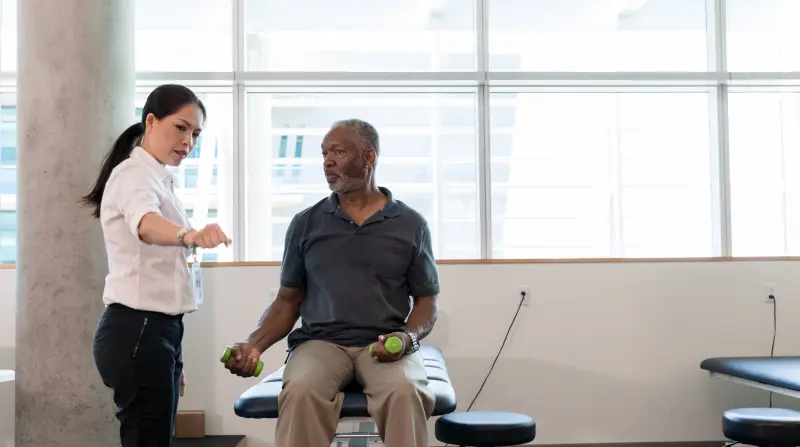
- Sit next to a table, & relax the injured arm along the tabletop with your hand hanging over the side to the body, & palm facing the floor. Hold an object that is hard & heavy, like a hammer, but not so heavy. You should be able to hold it easily in your hand. Slowly rotate your forearm so you are elevating the object up towards the ceiling, & keeping your arm flat on the table. When you have reached as high as you can go, & reverse the direction & move the object lower. Repeat this movement ten times, rest a minute, & then do 2 more sets.
- physical therapist examining a man’s arm movement in a rehabilitation center.
Wrist Deviation

- Sit at a table with the forearm twisted, with your hand over the side. But this time, your palm faces the side of the body, as if you are about to shake hands with someone. Keep your arm firmly on the table, & elevate your hand up & lower in a hand-shaking motion. Repeat about 10 times. Rest and repeat one more time. You can do this exercise a few times a day like 2-3 times.
Wrist Curls

- Sit at the table with your hand over the side, & your palm facing the ceiling, and relaxed position. Holding a one or two-pound weight, & slowly elevate your hand, curling at the wrist. Lower slowly. Repeat this about ten times as with the wrist deviation. If you do not have a small dumbbell, a filled water bottle will also do the trick.
- woman-sitting-down-lifting-weights
Bicep Curls

- Sit on a chair with your legs moderately spread apart in front of you. Holding a lightweight, place your elbow on your thigh, the palm of your hand, and the weight facing the ceiling. Slowly bring your hand & weight up to your chest, & keeping your elbow joint on your thigh. Repeat ten times, rest, & do it again.
Try a few regulars of these exercises each day, for a week. Add on a new exercise each week. You may also desire to swap one for another. Don’t try every exercise every day. If you do too much too soon, you will further stress the soft tissues throughout your arm & they would not heal.
Prevention for tennis elbow
How to Prevent Tennis Elbow?
- Ceasing or decreasing repetitive activities & relaxing the arm can aid healing. When relaxing is not possible, adjusting arm motions can help to ease symptoms. For example, a person can try keeping their palms flat & elbow joints bent when lifting.
- Doing exercises designed for tennis elbow helps strengthen forearm muscles & increase function. People whose jobs involve a repetitive motion of the forearm should do these exercises to stop tennis elbow from returning.
- Always consult a doctor before trying exercises for tennis elbow. A doctor can make sure that the exercises will not impact any underlying conditions or injuries.
- To decrease the risk of tennis elbow, it is most important to pay awareness to motion techniques during exercise or exertion.
- It is better to spread the load to the larger muscles of the shoulder joint & upper arm, rather than focus activity on the smaller muscles in the wrist joint & the elbow joint.
- Warming up: Warming up before playing a sport that involves repetitive arm motions, such as tennis or squash, is essential. Gently stretching the arm muscles will help to keep away from injury.
- Using small weight tools: Lighter sports equipment or racquets with a larger grip size will help decrease strain on the tendons. Damp tennis balls & older balls load the arm with unnecessary force.
- Improving the strength of forearm muscles: This can help support arm motion & prevent tennis elbow.
- A physiotherapist can also recommend suitable exercises to help strengthen the appropriate muscles.
Tips for Prevention
- Exercises to stretch & strengthen your wrist joint & forearm muscles can be a big help in preventing tennis elbow. There is also plenty you can do throughout your day to lessen the strain on your elbow joint.
- General tips: Avoid making the same hand & arm motions over & over. If that is not an option for you, & wear a brace & take breaks as often as you can. Some other tips:
- Learn to use your shoulder joint & upper arm muscles to take the strain off your elbow joint.
- Stick to the middle of your range of movement & avoid bending(flexing) or straightening your arm all the way.
- Warm up & stretch before sports & other activities where you repeat the same movements with your arm.
- At work: Avoid working with a bent wrist. Keep it straight, if possible. A couple of other ideas:
- Stick with smooth motion instead of sharp, & jerky ones.
- Talk to your manager about turning jobs, doing different tasks, or changing your workstation setup to decrease strain.
- Using tools: Go with tools that have bigger grips & strength. You can wear gloves or add padding or cushion to help. You should also:
- Hold tools with a looser or weak grip; take some of the tension out of your hand, if you can.
- If you use a hammer, use one with padding to help take up shock.
- On the court: Make sure your racquet’s right for your body. Lighter weight, larger grips, and softer strings may decrease the strain on your tendons. Also:
- Ask a coach to help with your form. The correct technique can help keep away from injury.
- Stick with a two-handed backhand.
- Use your whole lower body to put power into your punch, not just your arm.
What are some exercises you should avoid to keep your tennis elbow from worsening?
The therapeutic exercises that physiotherapists typically prescribe for tennis elbow are designed to be moderate. They can also help stretch & strengthen the forearm muscles & elbow ligaments injured by this injury. However, there are certain types of exercise physiotherapists typically keep away from when working with tennis elbow patients. 3 of these are:
Repetitive weight-bearing exercises
Many exercises required holding up most of your body weight while moving your arms. The chin-up is one most common examples. Pushups are another example of a common exercise that descends into this category. For tennis elbow patients, such exercises place a lot of tension on the affected elbow. This tension can slow down your healing or even affect your elbow further.
High-weight wrist exercises
physiotherapists often prescribe wrist exercises as part of a tennis elbow therapy plan. However, the exercises they prescribe are done with small or no weight. You might be used to doing barbell extensions and other exercises that use a lot of weight, but you’ll want to avoid them during your recovery. If you do not, it is possible that your healing could be longer than you thought
Straight-arm exercises
Straight arm exercises like planks are popular for building core strength and conditioning programs. Other exercises in this category, like pullovers & L-sits, are popular for building arm strength and also forearm strength. However, doing these types of exercises is not performed when you have tennis elbow. Straight-arm exercises require that you hold your arm hard for extended or long periods of time. This places a huge amount of tension and pressure on the elbow tendons & forearm muscles, which can impede your healing.
The elbow is a joint that people use to make lifting motions with the arm, & it also plays a role in twisting the forearm & hand. These motions become much harder & more painful when you have tennis elbow. Also called lateral epicondylitis, this condition occurs when the tendons in the outside of your elbow joint become inflamed, & the injury is typically caused by repetitively moving the elbow joint. There are some exercises that can help speed up the recovery of lateral epicondylitis. However, there are 3 exercises you should keep away from if you have tennis elbow.
Pushups
Pushups are a very popular body-weight exercise. However, this exercise is one that you should definitely keep away from if you have tennis elbow. Pushups are designed to work your triceps, pectorals, & shoulders, but you will have to bend or flex your elbows joint repeatedly to do them. This means that you will be worsening the strain on already affected elbow tendons.
Chin-ups
Another common exercise people should keep away from when healing from tennis elbow is chin-ups. This exercise typically involves pulling your body weight up using your arm, shoulder, & back muscles, & many people consider this exercise to be an excellent addition to a workout. However, it does place a lot of tension on the elbow tendons, which is one reason it is a no-go if you have tennis elbow. It also involves repeated elbow motions, which is another strike against the chin-up.
Dumbbell wrist curls
Difficult body-weight exercises like chin-ups & pushups are not the only one’s tennis elbow sufferers should keep away from. There are even some apparently easy exercises that you may want to shy away from until you heal. An example of such an exercise is the small dumbbell wrist curl. The main reason to keep away from this exercise is that it is specifically designed to work the muscles of the forearm, & these are the exact muscles that are connected to your affected elbow tendon
The activities that initially caused your injury, & typically due to overuse or repetitive movements, will probably need to be stopped or modified the activities.
Here is a list of exercises to avoid to minimize strain & aggravation & maximize the benefits of weight lifting for tennis elbow. For more personalized education & recommendation, talk to a physiotherapist or personal trainer.
- Using a barbell. It will promote muscle imbalances. Choose free weights instead.
- Any exercise that requires full upper body strength is hard to modify, such as pull-ups, push-ups, & dips.
- High-intensity exercises involved with cross-fit or TRX.
- Any exercises that cause muscle guarding or onset of mild to severe pain.
- Exercises with the elbow straight or locked. This accelerates strain on the forearm muscles.
- Any motions that mimic what caused the injury (aka swinging).
- Strength exercises that keep the palms facing downward, & such as reverse biceps, side raises, & upright rows.
- Staying Safe While Lifting Weights
- As with any healing program, tune into your symptoms to know what you should be doing. If you feel any change in symptoms such as severe pain, numbness, tingling, or a reduction in hand or wrist strength talk, to a medical professional as soon as possible. Healing from an elbow joint injury is all about patience. With time & diligence, you will slowly be able to return to your previous level of activity.
Is it ok to work out or lift weights with a tennis elbow?
Lifting Weights with Tennis Elbow Pain
When the time is right, & lifting or elevating small weights with a tennis elbow is the most important part of the healing process. However, it is crucial to understand how to elevate correctly & when is the right time to start. Keep analyzing to learn more about how to strengthen your elbow joint & forearm muscles.
Using the muscles in your elbow joint with a good strengthening routine will help circulation to the entire arm. This will expedite the recovery of the injured inflamed tendons. The key is finding exercises that help tendon health & minimize additional strain on the area.
In general, mild pain with exercise is expected & normally means you help to change your approach or modify, such as reducing range, & resistance with strengthening for tennis elbow. Alternatively, moderate to severe pain signs to stop the exercise program altogether.
How to Lift Weights with Elbow Pain
- When lifting weights with elbow pain, it is important to start small & slow. While paying close attention to your symptoms, & you can gently increase progress from there.
- Consider starting your program with range-of-movement exercises for the elbow joint to reduce stiffness
- If the elbow joint muscles feel tense & guarded then warm them up first with an elbow joint massage.
- When initiating exercises, start with a low or small weight, a light resistance band, or even no resistance.
- To help to heal, do high-repetition exercises to build endurance & help blood flow (15 or more repetitions).
- Keep good form with each exercise to minimize strain & pain. Elbow Kinesio taping can help out with this.
- Some ache is normal, if you have soreness that lasts more than 24 hours, then modify it the next time you finalize your program.
- Consider using a heat pack or ice pack after your exercise program to address any lingering symptoms & pain relief.
- If you are not sure where to start, talk to your orthopedic doctor or consider a round of physical rehabilitation therapy.
Weight Lifting Exercises for Tennis Elbow
Whether you are an athlete, such as a tennis player, or not the following tennis elbow conditioning exercise is a great place to start. These will promote and address symptoms of tennis elbow & begin your injury-healing process.
Wrist Extension
This exercise will strengthen your wrist extensor muscles. Find a relaxing place to support your forearm with the palm facing downward, & such as a sitting position with your arm on your thigh or at a table. Holding a small weight or dumbells ½ to 2 lbs, & simply extend or straighten the wrist joint up toward the ceiling. Make sure only the wrist is moving. Keep the movement slow and controlled
Do 15-20 repetitions for 2-3 sets. Modify the weight to your relaxing level.
Wrist Deviations
Again, support the arm & choose a lightweight, if any. This time, hold the wrist joint in a neutral straight position not bent or extended. Then, move the wrist joint from side to side. The movement will be small. Alternatively, you can rotate your hand so that the thumb is facing up and do the same movement as described.
Complete 15-20 repetitions for 2-3 sets.
Forearm Supination/Pronation
With the arm supported, & hold a small weight in the hand with the thumb facing up. You will be holding the base of the dumbbell so that most of the weight is above your hand. Then, slowly turn your hand & wrist so that your palm is facing down. Return to the starting position or relax position, & then turn it in the opposite direction until your palm is facing upward.
Move back & forth between these 2 positions 15-20 times for two to three sets. You can start without any weight if helpful.
Elbow Pain During Exercise
Pain with tennis elbow is created by inflammation of the forearm muscle tendons, also known as tendonitis. Treating tendonitis with exercise therapy requires a unique balance. The proper motion will adequately tension the tendons of the outside elbow enough to help blood flow & healing. However, since these areas are inflamed they can also cause pain, & even aggravation if overdone.
A great way to balance exercise is with elbow stretches & pain-relieving modalities.
FAQ
What is the rapid way to cure tennis elbow?
Lifestyle and home remedies
Rest: Avoid activities that increase your elbow pain.
Pain relievers: Try over-the-counter pain relievers, such as use ibuprofen or naproxen.
Ice. Apply ice or a cold pack for 15 minutes 3 to 4 times a day.
Technique.
What exercises should I avoid with tennis elbow?
Chin-ups, pushups, & bench presses: All of these motions put a strain on your elbow’s flexors, which can lead to the further annoyance of the lateral tendons of your elbow. Wrist exercises: It is best to keep away from any wrist exercises, especially forearm dumbbell curls or barbell extensions.
How do you sleep with tennis elbow?
The 3 tips for sleeping well with tennis elbow
keep away from sleeping on the affected arm. Many people are most relaxed sleeping on their side, but this can also cause problems when you are sleeping with tennis elbow. …
Support your elbow with pillows. …
Use a brace while sleeping.
Can I go to the gym or work out with my tennis elbow?
If you have Tennis Elbow or Golfer’s Elbow you can certainly continue with your cardio exercise and lower-body workout (that’s probably obvious and uncontroversial!)
Can I still lift weights with my tennis elbow?
Repetitive lifting or movements: Exercises that rely on repetitive lifting or repetitive movements of your elbow joint & wrist joint can agitate your injury. When you are working out in this condition, do as few repetitions as possible.



